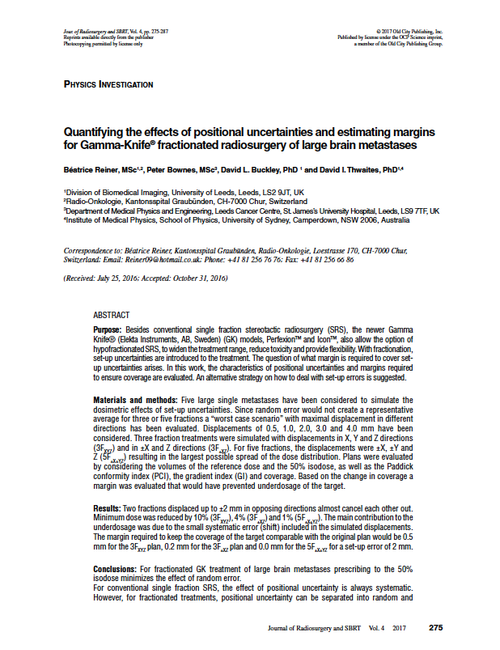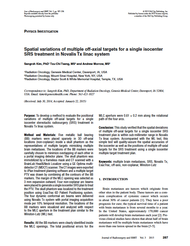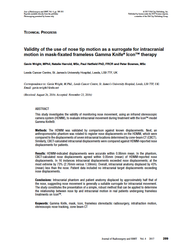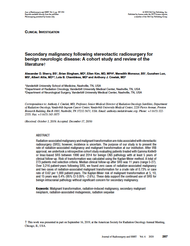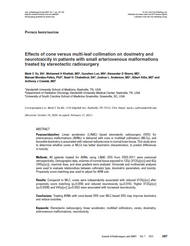- Home
- Journal Contents Downloads
- JRSBRT Downloads
- JRSBRT 4.4, p. 275-287
Product Description
Physics Investigation
Quantifying the effects of positional uncertainties and estimating margins for Gamma-Knife® fractionated radiosurgery of large brain metastases
Béatrice Reiner, Peter Bownes, David L. Buckley and David I. Thwaites
Purpose: Besides conventional single fraction stereotactic radiosurgery (SRS), the newer Gamma Knife® (Elekta Instruments, AB, Sweden) (GK) models, Perfexion™ and Icon™, also allow the option of hypofractionated SRS, to widen the treatment range, reduce toxicity and provide flexibility. With fractionation, set-up uncertainties are introduced to the treatment. The question of what margin is required to cover setup uncertainties arises. In this work, the characteristics of positional uncertainties and margins required to ensure coverage are evaluated. An alternative strategy on how to deal with set-up errors is suggested.
Materials and methods: Five large single metastases have been considered to simulate the dosimetric effects of set-up uncertainties. Since random error would not create a representative average for three or five fractions a “worst case scenario” with maximal displacement in different directions has been evaluated. Displacements of 0.5, 1.0, 2.0, 3.0 and 4.0 mm have been considered. Three fraction treatments were simulated with displacements in X, Y and Z directions (3FXYZ) and in ±X and Z directions (3F±XZ). For five fractions, the displacements were ±X, ±Y and Z (5F±X±YZ) resulting in the largest possible spread of the dose distribution. Plans were evaluated by considering the volumes of the reference dose and the 50% isodose, as well as the Paddick conformity index (PCI), the gradient index (GI) and coverage. Based on the change in coverage a margin was evaluated that would have prevented underdosage of the target.
Results: Two fractions displaced up to ±2 mm in opposing directions almost cancel each other out. Minimum dose was reduced by 10% (3FXYZ), 4% (3F±XZ) and 1% (5F±X±YZ). The main contribution to the underdosage was due to the small systematic error (shift) included in the simulated displacements. The margin required to keep the coverage of the target comparable with the original plan would be 0.5 mm for the 3FXYZ plan, 0.2 mm for the 3F±XZ plan and 0.0 mm for the 5F±X±YZ for a set-up error of 2 mm.
Conclusions: For fractionated GK treatment of large brain metastases prescribing to the 50% isodose minimizes the effect of random error. For conventional single fraction SRS, the effect of positional uncertainty is always systematic. However, for fractionated treatments, positional uncertainty can be separated into random and systematic components, where random displacements in opposing directions at least partially cancel each other out and thus reduce the overall systematic effect (i.e. from the residual systematic uncertainty). Therefore fractionated schemes with more fractions are preferable from the point of view of accounting for positional uncertainties. If the random and systematic uncertainties can be assessed and determined separately by imaging, then the residual systematic value can be corrected for the remaining fractions.
Keywords: Gamma Knife, Perfexion, eXtend™, Icon
After payment has been processed for your order of a digital copy (PDF) of this article, you will see a download link on your completed order page and also receive an email containing a download link. The links, which will enable you to download one copy of the article, will expire after 24 hours.
 Loading... Please wait...
Loading... Please wait...

